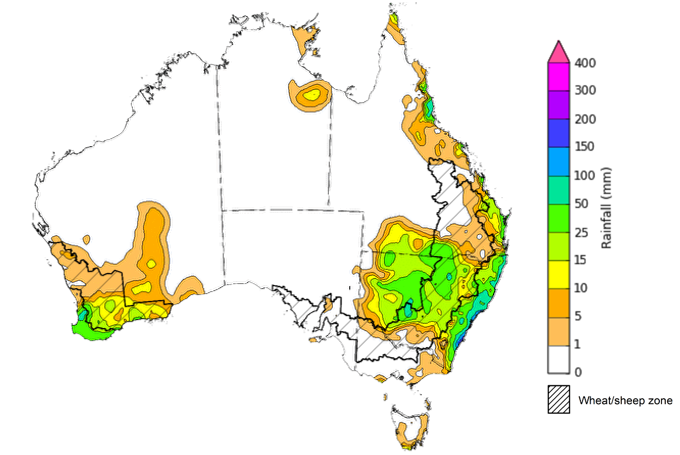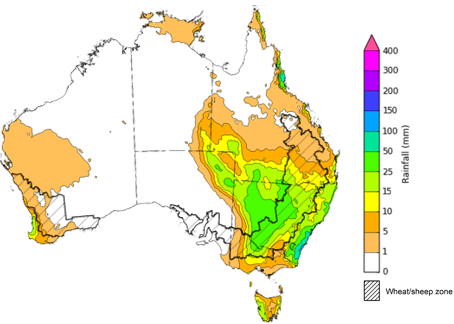Key issues
- In the week ending 9 May 2024, dry conditions dominated much of Australia. However, a low pressure system and a series of troughs brought rainfall totals ranging from 10 to 150 millimetres to much of New South Wales and parts of southern and north-eastern Queensland. A cold front brought rainfall totals of up to 100 millimetres to parts of southwest Western Australia.
- Cropping regions in Queensland, New South Wales and Western Australia will benefit from the boost in soil moisture levels required for winter crops and pasture growth.
- However, this rainfall would have delayed field access for winter crop planting in some cropping areas.
- Over the coming days, low-pressure troughs are forecast to generate up to 150 millimetres of rainfall in New South Wales, and 50 millimetres of rainfall in southern Queensland, central Victoria and parts of north-eastern South Australia. Additionally, lows are expected to bring a maximum of 25 millimetres to coastal south-western Western Australia. A tropical low is expected to bring up to 100 millimetres of rainfall in isolated parts of northeast Queensland.
- Risks to production from low soil moisture levels remain in cropping areas of South Australia, Western Australia and western Victoria.
- A wet week in New South Wales will likely disrupt field access.
- The national rainfall outlook for June to August is for above median rainfall for much of southern half of Australia.
- The national rainfall outlook is for equal chances of above or below median rainfall for much of Australian cropping regions over the next three months.
- Across cropping regions, equal chances of above or below median rainfall are likely.
- o If positive Indian Ocean Dipole eventuates, it would be earlier than usual and may influence rainfall over the winter period in the southern cropping regions.
- Water storage levels in the Murray-Darling Basin (MDB) decreased between 29 April 2024 and 9 May 2024 by 63 gigalitres (GL). Current volume of water held in storage is 16 542 GL, equivalent to 74% of total storage capacity. This is 16 percent or 3,581 GL less than at the same time last year. Water storage data is sourced from the BOM.
- Allocation prices in the Victorian Murray below the Barmah Choke decreased from $21 on 18 April 2024 to $20 on 02 May 2024. Prices are lower in the Murrumbidgee due to the binding of the Murrumbidgee export limit.
Climate
For the week ending 9 May 2024, high-pressure systems kept much of Australia mainly dry. However, a low-pressure system and a series of troughs brought rainfall totals ranging from 10 to 150 millimetres to much of New South Wales and parts of southern and north-eastern Queensland. A cold front brought rainfall totals of up to 100 millimetres to parts of southwest Western Australia.
In cropping regions, low-pressure systems brought rainfall totals ranging between 10 and 100 millimetres to central and northern New South Wales, parts of south-western Queensland, and southern Western Australia. A maximum of 5 millimetres was recorded in areas of eastern Queensland and northern Western Australia. A lack of rainfall in the south is likely to lead to a reduction in soil moisture available for the winter cropping period and likely to see a continuation of dry sowing crops in South Australia, Victoria and northern Western Australia.
High rainfall in parts of New South Wales is likely to continue to support pasture growth and the germination and establishment of winter crops but is likely to delay further planting activity until paddocks dry sufficiently to allow access. In Western Australia, this week’s rainfall is likely to provide some relief to depleted soil moisture in southern cropping regions after an extended period of low rainfall.
Rainfall for the week ending 8 May 2024

Over the 8 days to 16 May, low-pressure troughs are forecast to generate up to 150 millimetres of rainfall in New South Wales, and 50 millimetres of rainfall in southern Queensland, central Victoria and parts of north-eastern South Australia. Additionally, lows are expected to bring a maximum of 25 millimetres to coastal south-western Western Australia. A tropical low is expected to bring up to 100 millimetres of rainfall in isolated parts of northeast Queensland. Much of the remainder of the country is expected to record little to no rainfall.
Across cropping regions, conditions in eastern areas are expected to be generally wet, with a maximum of 50 millimetres of rainfall in New South Wales, central Victoria and southern Queensland. This is expected to support the growth of planted winter crops, but wet conditions may hinder field access and delay the planting of winter crops in some areas.
South Australia and western Victoria are likely to receive little to no rainfall over this period due to a high-pressure system developing in the Great Australian Bight. Similarly, Western Australian cropping regions are expected to receive a maximum of 5 millimetres of rainfall. This continues to present a risk of declining soil moisture levels in these areas.
Total forecast rainfall for the period 9 May to 16 May 2024

The most recent rainfall outlook for June 2024 provided by the Bureau of Meteorology indicates an increased likelihood of above median rainfall across much of Australia. Below median rainfall is more likely across parts of tropical northern Australia, central Victoria and Tasmania. There is an equal chance of either above or below median rainfall likely elsewhere.
According to Bureau of Meteorology’s climate model, for June 2024 there is a 75% probability of rainfall totals reaching up to 50 millimetres across coastal and inland New South Wales, Victoria, and coastal Queensland. Southwestern coastal Western Australia and western Tasmania are anticipated to receive up to 200 millimetres of rainfall. The Northern Territory is expected to remain largely dry, with a maximum of 5 millimetres anticipated.
Across cropping regions, there is a 75% chance of rainfall totals of up to 50 millimetres in New South Wales and Victoria, and western South Australia. In Queensland, a maximum of 25 millimetres is expected in the south. June rainfall totals for Western Australia are forecast to range between 10 millimetres in the east to 50 millimetres in the west. This anticipated rainfall will benefit the germination and establishment of winter crops.
Rainfall totals that have a 75% chance of occurring in June 2024
![Map showing the rainfall totals that have a 75% chance of occurring during the next month in Australia. Image provided by the Bureau of Meteorology. Please refer to accompanying text for a more detailed description. For further information, go to http://www.bom.gov.au/climate/ahead/about/.]](/sites/default/files/images/rain.forecast.calib_.scenario.75.national.month1_.latest.hr__43.png)
The El Niño Southern Oscillation (ENSO) conditions are likely to remain neutral until July 2024. The Indian Ocean Dipole (IOD) index has been above the positive IOD threshold for seven consecutive weeks. For positive IOD to be declared, the index must be above positive IOD threshold for minimum eight consecutive weeks.
The rainfall outlook for June through August indicates that above median rainfall is more likely across much of the southern half of Australia. In the Northern Tropics, which has entered its dry season, rainfall totals over the period are expected to be below the median. Victoria and Tasmania have an equal chance of having above or below median rainfall. Across cropping regions, the probability of exceeding median rainfall is between 40% and 60%.
Chance of exceeding the median rainfall June to August 2024
![Map showing the chance of exceeding median rainfall during the next three months in Australia. Image provided by the Bureau of Meteorology. Please refer to accompanying text for a more detailed description.]](/sites/default/files/images/rain.forecast.median.national.season1.latest.hr__44.png)
The outlook for June to August 2024 suggests there is at least a 75% chance of rainfall totals of up to 200 millimetres across much of southern Australia, with up to 400 millimetres likely in scattered parts of New South Wales and Victoria. In Tasmania, rainfall is likely to reach 800 millimetres in the west over the period. Southwest Western Australia is likely to see up to 600 millimetres of rainfall in far southwestern coastal areas. In contrast, northern Australia is likely to remain dry, with a maximum of 25 millimetres expected in the Northern Territory over the period.
Across cropping regions, there is at least a 75% chance of receiving between 100 and 200 millimetres in the south, with Queensland likely to see a maximum of 100 millimetres. Considering the recent declines in upper layer soil moisture levels, particularly in South Australia, Western Australia and western parts of Victoria, sufficient and timely rainfall will be required in the coming months to facilitate the sowing and establishment of winter crops. This positive outlook of June to August rainfall is expected to support the germination of dry sown crops and follow up winter crop planting towards the end of the ideal planting window (i.e. end of June).
Livestock producers, especially those in the south, are expected to experience close to average pasture production on the back of the improving rainfall outlook over the June to August period.
Rainfall totals that have a 75% chance of occurring June to August 2024

Water
Water storages, water markets and water allocations - current week
The Tableau dashboard may not meet accessibility requirements. For information about the contents of these dashboards contact ABARES.
Commodities
Information on weekly price changes in agricultural commodities is now available at the Weekly commodity price update.
